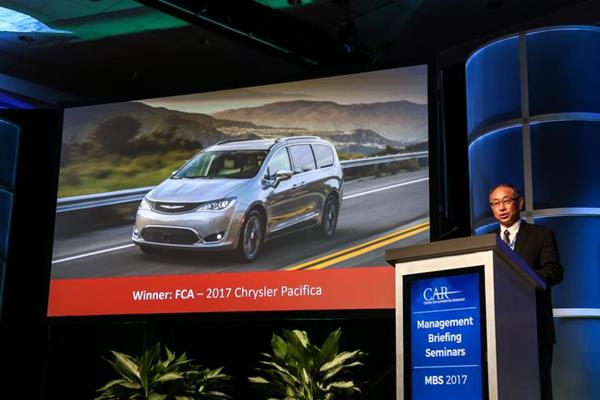For the module category, which focuses on vehicle systems, subsystems and components, the international judging panel awarded the top prize to both Toyota and Faurecia. Toyota’s winning entry concerned the side and luggage doors of the 2017 Lexus LC and the liftgate of the 2017 Toyota Prius Prime, which feature carbon fiber reinforced plastic (CFRP) inner panels, combined with aluminum, glass-fiber reinforced plastic (GFRP) and polypropylene outers for components that are 47% lighter than conventional metal structures.
 Richard Yen, senior vice president, Automotive and Global Markets Team, Altair, at the 2017 Enlighten Awards Presentations at the Center for Automotive Research (CAR) Management Briefing Seminars (MBS).
Richard Yen, senior vice president, Automotive and Global Markets Team, Altair, at the 2017 Enlighten Awards Presentations at the Center for Automotive Research (CAR) Management Briefing Seminars (MBS).Faurecia’s winning entry was the Adaptive Valve, an offset shaft spring return butterfly valve located in the intermediate pipe of the exhaust system. Its specific purpose is to address NVH concerns caused by cylinder deactivation by presenting the gas flow with a variable restriction. The valve requires less package space than traditional systems and its innovative design reduced the muffler weight of the 2017 Chevrolet Silverado by 26.5 lbs. (12 kg).
Finally, the Enabling Technology category, a new award introduced in 2017 to recognize technological advances that enable manufacturers to save weight, was claimed by AP&T. The company’s aluminum forming technology is a multipurpose production line for high strength aluminum sheet metal, enabling flexibility in the forming of high strength car body components with complex shapes, leading to weight savings between 30% and 50%.
The runner-up for this year’s Full Vehicle award was Honda for the multi-material space frame used to make the 2017 Acura NSX 48.5 lbs. (22 kg) lighter. Constellium claimed the second place title in the Enabling Technology category for the HSA6 aluminum alloys, which support the development of vehicles that are 15% to 30% lighter than those produced using conventional 6000-series aluminum alloys.
The Altair Enlighten Award honors the greatest achievements in vehicle weight saving each year to inspire interest from policymakers, educators, students and the public, to create further competition for new ideas in the industry and to provide an incentive to share technological advances. The award is judged by a combination of automotive experts from industry, academia and the engineering media from across the world who debated the merits of each of the 29 finalists.






